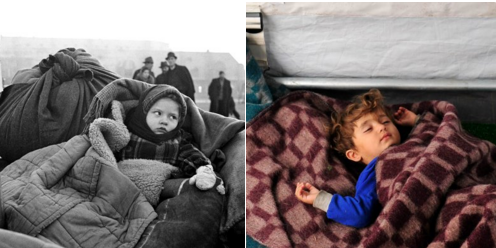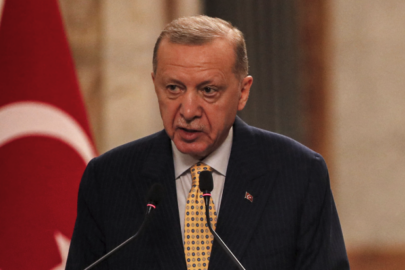
In 1946, inside Germany, a small displaced girl is wrapped in blankets and sits on a mound of other refugee belongings. © UNICEF archives.

In 2015, a child sleeps on the floor of a UNICEF child-friendly space set up at a reception centre for refugees and migrants in Preševo, Serbia. © UNICEF/Georgiev
In 1946, children wore clothes donated by the citizens of host countries. Today, the needs are much the same. Children’s clothes, food and supplies, like nappies, for infants are in high demand. UNICEF is helping mothers find the necessary supplies for their children.

In 1946, in Greece, refugee children are handed their first meal supplied by a United Nations agency. © UNICEF archives.

In 2015, a young boy eats a sandwich made by volunteers helping at a refugee registration site set up by UNHCR on the Greek border. © UNICEF/Georgiev
So many of the children UNICEF is helping are confused, physically exhausted and traumatised. Some even need medical assistance. Although food security and access to safe drinking water have generally improved along transit routes over the past month, serious concerns remain about the way these services are adapted to children. UNICEF continues to work to ensure suitable foods for children of all ages are available to keep them healthy.

In 1946, in Italy, children carry rocks from a war-destroyed building to help rebuild their town. © UNICEF/Romagnoli

In 2015, a young boy carts a drink container the 10-min walk back to the Greek refugee reception centre. © UNICEF/Georgiev
More than 930,000 people have travelled to Europe by sea this year, with a peak of 10,000 people arriving on a single day in October. The majority of people registered originated from Syria, Afghanistan and Iraq. Children of all ages have been travelling with their families, and sometimes alone. Between June and November, almost 12,500 children were found to be travelling alone.

In 1946, in Greece, three girls peer through the window of a schoolhouse where a UN medical clinic has been set up. © UNICEF Archives

In 2015, a boy attempts to stay dry in wet weather, in the town of Gevgelija, on the border with Greece. © UNICEF/Georgiev
Rain and cold weather represents a major challenge for refugees and migrants arriving in the former Yugoslav Republic of Macedonia, especially when they have to wait for long hours at the border for registration. UNICEF continues to advocate for the health and safety of children in transit, who are exposed to poor weather and exhausted.

In 1946, in Poland, a refugee family returning from Rudki, south of the Ukrainian city of Lvov, rests on a pile of their belongings during their travel west to the farm that awaits them in the south-western Lower Silesia region. © UNICEF Archives

In 2015, a man holds a baby at the reception centre for refugees and migrants, in the town of Šid, on the border with Croatia. © UNICEF/Shubuckl
Asylum seekers wait lengthy periods to be registered. Even though many of the registration centres can accommodate families overnight, many choose to travel on and try elsewhere. Processing of a refugee claim is drawn out and complex with only a handful of people being granted refugee status since the beginning of the year.

In 1946, three boys share a desk and receive UNICEF-led schooling near where their families are stationed in the then Yugoslavia. © UNICEF Archives

In 2015, a young girl writes and draws while waiting for a train to take her from the Former Yugoslav Republic of Macedonia to Serbia. © UNICEF/Klincarov
One in every four asylum seekers crossing Europe is a child. More than 214,000 children have sought safety and refuge in a European Union country between January and September this year. That’s almost 24,000 children every month.
On the border of Greece and the Former Yugoslav Republic of Macedonia, UNICEF has set up safe places for children to rest and play while families complete registration procedures or wait for transport. The spaces support up to 100 children at a time.





































